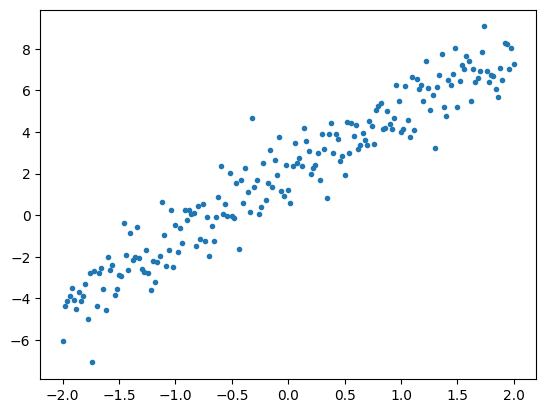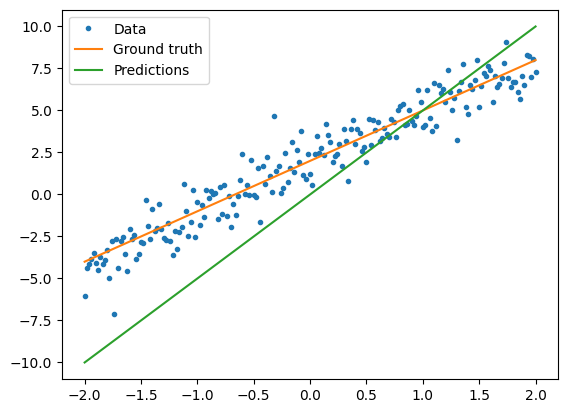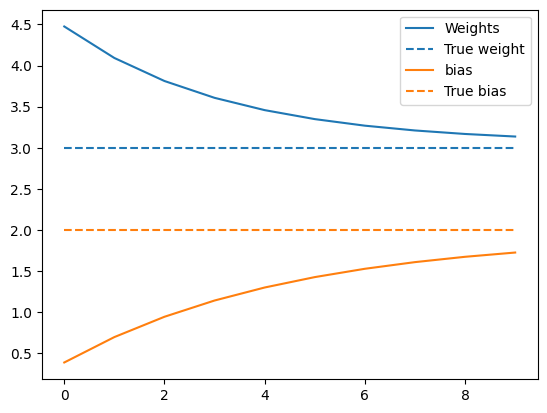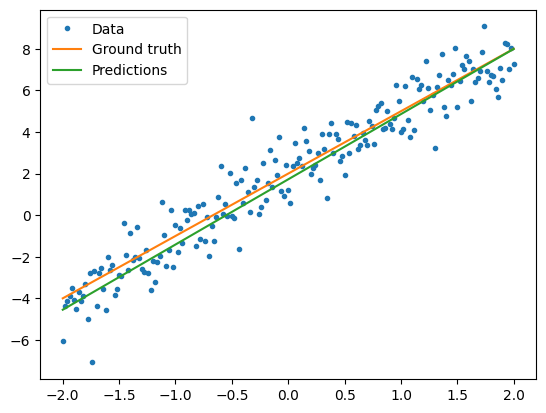基本训练循环#
 在 TensorFlow.org 上查看 在 TensorFlow.org 上查看 |
 在 Google Colab 中运行 在 Google Colab 中运行 |
 在 GitHub 上查看源代码 在 GitHub 上查看源代码 |
 下载笔记本 下载笔记本 |
在前面的教程里,您已经了解了tensors, variables, gradient tape, 和modules。在这篇教程,您将把它们放在一起训练模型。
此外,TensorFlow 还包括 tf.Keras API,这是一种高级神经网络 API,可提供有用的抽象来减少样板。但是,在本指南中,您将使用基本类。
创建#
from set_env import temp_dir
import tensorflow as tf
import matplotlib.pyplot as plt
colors = plt.rcParams['axes.prop_cycle'].by_key()['color']
解决机器学习问题#
解决一个机器学习问题通常包含以下步骤:
获得训练数据。
定义模型。
定义损失函数。
遍历训练数据,从目标值计算损失。
计算该损失的梯度,并使用optimizer调整变量以适合数据。
计算结果。
为了便于说明,在本指南中,您将开发一个简单的线性模型, \(f(x) = x * W + b\), 其中包含两个变量: \(W\) (权重) 和 \(b\) (偏差)。
这是最基本的机器学习问题:给定 \(x\) 和 \(y\),尝试通过简单的线性回归来找到直线的斜率和偏移量。
数据#
监督学习使用输入(通常表示为 x)和输出(表示为 y,通常称为标签)。目标是从成对的输入和输出中学习,以便您可以根据输入预测输出的值。
TensorFlow中几乎每个输入数据都是由张量表示,并且通常是向量。监督学习中,输出(即想到预测值)同样是个张量。
下面是通过将高斯(正态)噪声添加到直线上的点而合成的一些数据。
# The actual line
TRUE_W = 3.0
TRUE_B = 2.0
NUM_EXAMPLES = 201
# A vector of random x values
x = tf.linspace(-2,2, NUM_EXAMPLES)
x = tf.cast(x, tf.float32)
def f(x):
return x * TRUE_W + TRUE_B
# Generate some noise
noise = tf.random.normal(shape=[NUM_EXAMPLES])
# Calculate y
y = f(x) + noise
# Plot all the data
plt.plot(x, y, '.')
plt.show()

张量通常以 batches 的形式聚集在一起,或者是成组的输入和输出堆叠在一起。批处理能够对训练过程带来一些好处,并且可以与加速器和矢量化计算很好地配合使用。给定此数据集的大小,您可以将整个数据集视为一个批次。
定义模型#
使用 tf.Variable 代表模型中的所有权重。tf.Variable 能够存储值,并根据需要以张量形式提供它。详情请见 variable guide。
使用 tf.Module 封装变量和计算。您可以使用任何Python对象,但是通过这种方式可以轻松保存它。
这里,您可以定义 w 和 b 为变量。
class MyModel(tf.Module):
def __init__(self, **kwargs):
super().__init__(**kwargs)
# Initialize the weights to `5.0` and the bias to `0.0`
# In practice, these should be randomly initialized
self.w = tf.Variable(5.0)
self.b = tf.Variable(0.0)
def __call__(self, x):
return self.w * x + self.b
model = MyModel()
# List the variables tf.modules's built-in variable aggregation.
print("Variables:", model.variables)
# Verify the model works
assert model(3.0).numpy() == 15.0
Variables: (<tf.Variable 'Variable:0' shape=() dtype=float32, numpy=0.0>, <tf.Variable 'Variable:0' shape=() dtype=float32, numpy=5.0>)
初始变量在此处以固定方式设置,但 Keras 提供了您可以与或不与 Keras 其他部分一起使用的许多初始值设定项。
定义损失函数#
损失函数衡量给定输入的模型输出与目标输出的匹配程度。目的是在训练过程中尽量减少这种差异。定义标准的L2损失,也称为“均方误差”:
# This computes a single loss value for an entire batch
def loss(target_y, predicted_y):
return tf.reduce_mean(tf.square(target_y - predicted_y))
在训练模型之前,您可以可视化损失值。使用红色绘制模型的预测值,使用蓝色绘制训练数据。
plt.plot(x, y, '.', label="Data")
plt.plot(x, f(x), label="Ground truth")
plt.plot(x, model(x), label="Predictions")
plt.legend()
plt.show()
print("Current loss: %1.6f" % loss(y, model(x)).numpy())

Current loss: 9.857544
定义训练循环#
训练循环按顺序重复执行以下任务:
发送一批输入值,通过模型生成输出值
通过比较输出值与输出(标签),来计算损失值
使用梯度带(GradientTape)找到梯度值
使用这些梯度优化变量
这个例子中,您可以使用 gradient descent训练数据。
tf.keras.optimizers中有许多梯度下降的变量。但是本着搭建的第一原则,您将在这里 借助tf.GradientTape的自动微分和tf.assign_sub的递减值(结合了tf.assign和tf.sub)自己实现基本数学:
# Given a callable model, inputs, outputs, and a learning rate...
def train(model, x, y, learning_rate):
with tf.GradientTape() as t:
# Trainable variables are automatically tracked by GradientTape
current_loss = loss(y, model(x))
# Use GradientTape to calculate the gradients with respect to W and b
dw, db = t.gradient(current_loss, [model.w, model.b])
# Subtract the gradient scaled by the learning rate
model.w.assign_sub(learning_rate * dw)
model.b.assign_sub(learning_rate * db)
要查看训练,您可以通过训练循环发送同一批次的 x 和 y,并观察 W 和 b 如何变化。
model = MyModel()
# Collect the history of W-values and b-values to plot later
weights = []
biases = []
epochs = range(10)
# Define a training loop
def report(model, loss):
return f"W = {model.w.numpy():1.2f}, b = {model.b.numpy():1.2f}, loss={loss:2.5f}"
def training_loop(model, x, y):
for epoch in epochs:
# Update the model with the single giant batch
train(model, x, y, learning_rate=0.1)
# Track this before I update
weights.append(model.w.numpy())
biases.append(model.b.numpy())
current_loss = loss(y, model(x))
print(f"Epoch {epoch:2d}:")
print(" ", report(model, current_loss))
进行训练
current_loss = loss(y, model(x))
print(f"Starting:")
print(" ", report(model, current_loss))
training_loop(model, x, y)
Starting:
W = 5.00, b = 0.00, loss=9.85754
Epoch 0:
W = 4.48, b = 0.39, loss=6.13083
Epoch 1:
W = 4.09, b = 0.70, loss=3.99869
Epoch 2:
W = 3.81, b = 0.94, loss=2.76916
Epoch 3:
W = 3.61, b = 1.14, loss=2.05437
Epoch 4:
W = 3.46, b = 1.30, loss=1.63538
Epoch 5:
W = 3.35, b = 1.43, loss=1.38779
Epoch 6:
W = 3.27, b = 1.53, loss=1.24029
Epoch 7:
W = 3.21, b = 1.61, loss=1.15176
Epoch 8:
W = 3.17, b = 1.67, loss=1.09822
Epoch 9:
W = 3.14, b = 1.72, loss=1.06562
下面是权重随时间的演变:
plt.plot(epochs, weights, label='Weights', color=colors[0])
plt.plot(epochs, [TRUE_W] * len(epochs), '--',
label = "True weight", color=colors[0])
plt.plot(epochs, biases, label='bias', color=colors[1])
plt.plot(epochs, [TRUE_B] * len(epochs), "--",
label="True bias", color=colors[1])
plt.legend()
plt.show()

呈现训练的模型的性能
plt.plot(x, y, '.', label="Data")
plt.plot(x, f(x), label="Ground truth")
plt.plot(x, model(x), label="Predictions")
plt.legend()
plt.show()
print("Current loss: %1.6f" % loss(model(x), y).numpy())

Current loss: 1.065623
使用Keras完成相同的解决方案#
将上面的代码与Keras中的等效代码进行对比很有用。
如果您将tf.keras.Model子类化,则定义模型与其看起来完全相同。请记住,Keras模型最终从模块继承。
class MyModelKeras(tf.keras.Model):
def __init__(self, **kwargs):
super().__init__(**kwargs)
# Initialize the weights to `5.0` and the bias to `0.0`
# In practice, these should be randomly initialized
self.w = tf.Variable(5.0)
self.b = tf.Variable(0.0)
def call(self, x):
return self.w * x + self.b
keras_model = MyModelKeras()
# Reuse the training loop with a Keras model
training_loop(keras_model, x, y)
# You can also save a checkpoint using Keras's built-in support
keras_model.save_weights(temp_dir/"my_checkpoint.weights.h5")
Epoch 0:
W = 4.48, b = 0.39, loss=6.13083
Epoch 1:
W = 4.09, b = 0.70, loss=3.99869
Epoch 2:
W = 3.81, b = 0.94, loss=2.76916
Epoch 3:
W = 3.61, b = 1.14, loss=2.05437
Epoch 4:
W = 3.46, b = 1.30, loss=1.63538
Epoch 5:
W = 3.35, b = 1.43, loss=1.38779
Epoch 6:
W = 3.27, b = 1.53, loss=1.24029
Epoch 7:
W = 3.21, b = 1.61, loss=1.15176
Epoch 8:
W = 3.17, b = 1.67, loss=1.09822
Epoch 9:
W = 3.14, b = 1.72, loss=1.06562
您可以使用Keras的内置功能作为捷径,而不必在每次创建模型时都编写新的训练循环。当您不想编写或调试Python训练循环时,这很有用。
如果您使用Keras,您将会需要使用 model.compile() 去设置参数, 使用model.fit() 进行训练。借助Keras实现L2损失和梯度下降需要的代码量更少,就像一个捷径。Keras损失和优化器也可以在这些便利功能之外使用,而前面的示例也可以使用它们。
keras_model = MyModelKeras()
# compile sets the training parameters
keras_model.compile(
# By default, fit() uses tf.function(). You can
# turn that off for debugging, but it is on now.
run_eagerly=False,
# Using a built-in optimizer, configuring as an object
optimizer=tf.keras.optimizers.SGD(learning_rate=0.1),
# Keras comes with built-in MSE error
# However, you could use the loss function
# defined above
loss=tf.keras.losses.MeanSquaredError(),
)
Kerasfit期望批处理数据或完整的数据集作为NumPy数组。 NumPy数组分为多个批次,默认批次大小为32。
这一案例中,为了匹配手写训练循环,您应该以大小为1000的单批次传递x。
print(x.shape[0])
keras_model.fit(x, y, epochs=10, batch_size=1000)
201
Epoch 1/10
1/1 ━━━━━━━━━━━━━━━━━━━━ 1s 1s/step - loss: 9.8575
Epoch 2/10
1/1 ━━━━━━━━━━━━━━━━━━━━ 0s 27ms/step - loss: 9.8575
Epoch 3/10
1/1 ━━━━━━━━━━━━━━━━━━━━ 0s 26ms/step - loss: 9.8575
Epoch 4/10
1/1 ━━━━━━━━━━━━━━━━━━━━ 0s 26ms/step - loss: 9.8575
Epoch 5/10
1/1 ━━━━━━━━━━━━━━━━━━━━ 0s 26ms/step - loss: 9.8575
Epoch 6/10
1/1 ━━━━━━━━━━━━━━━━━━━━ 0s 27ms/step - loss: 9.8575
Epoch 7/10
1/1 ━━━━━━━━━━━━━━━━━━━━ 0s 25ms/step - loss: 9.8575
Epoch 8/10
1/1 ━━━━━━━━━━━━━━━━━━━━ 0s 25ms/step - loss: 9.8575
Epoch 9/10
1/1 ━━━━━━━━━━━━━━━━━━━━ 0s 25ms/step - loss: 9.8575
Epoch 10/10
1/1 ━━━━━━━━━━━━━━━━━━━━ 0s 25ms/step - loss: 9.8575
/media/pc/data/lxw/envs/anaconda3x/envs/xxx/lib/python3.12/site-packages/keras/src/backend/tensorflow/trainer.py:75: UserWarning: The model does not have any trainable weights.
warnings.warn("The model does not have any trainable weights.")
WARNING: All log messages before absl::InitializeLog() is called are written to STDERR
I0000 00:00:1729853619.423943 4099174 service.cc:146] XLA service 0x7ff220004a00 initialized for platform CUDA (this does not guarantee that XLA will be used). Devices:
I0000 00:00:1729853619.423980 4099174 service.cc:154] StreamExecutor device (0): NVIDIA GeForce RTX 3090, Compute Capability 8.6
I0000 00:00:1729853619.423991 4099174 service.cc:154] StreamExecutor device (1): NVIDIA GeForce RTX 2080 Ti, Compute Capability 7.5
I0000 00:00:1729853620.350523 4099174 device_compiler.h:188] Compiled cluster using XLA! This line is logged at most once for the lifetime of the process.
<keras.src.callbacks.history.History at 0x7ff4804ed280>
请注意,Keras会在训练后而不是之前打印出损失,因此第一次损失会显得较低。否则,这表明本质上相同的训练效果。
下一步#
在这篇引导中,您已经看到怎样使用tensors, variables, modules, 和gradient tape去构建并训练模型,也进一步了解到这些是如何与Keras对应的。
但是,这是一个极其简单的问题。有关更实用的介绍,请参阅自定义训练演示。
有关使用内置 Keras 训练循环的更多信息,请参阅本指南。有关训练循环和 Keras 的更多信息,请参阅本指南。有关编写自定义分布式训练循环的信息,请参阅本指南。


